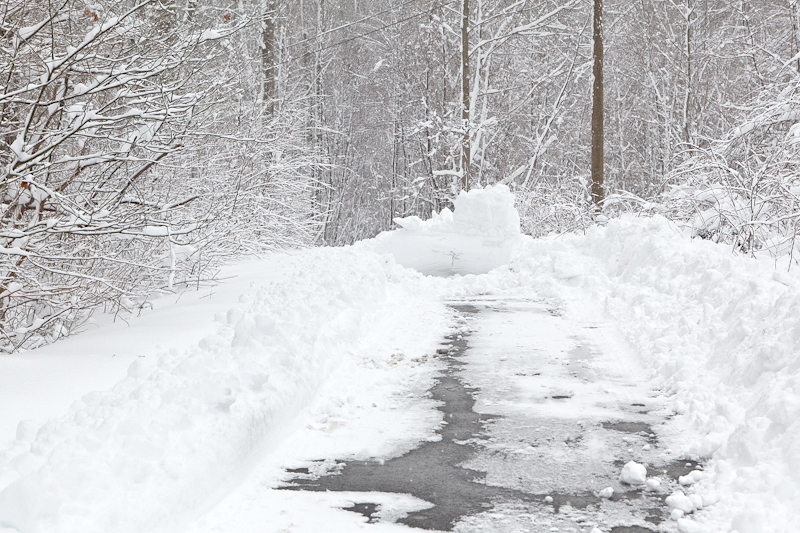Three steps for facing life’s most challenging situations
It was the perfect property for an outdoors-lover like myself.
There were nearly three acres of woodland brimming with wildlife. My family and I would see deer, turkeys and even a bear from our back door. The house was isolated from civilization, sitting on a nearly flood-proof plot of land.
The only drawback was the driveway. A long dirt road steadily heading up a hill with a few large curves and a steep drop-off on one side. It was what allowed the home to be so isolated and rustic. It also was a bear to deal with in the winter months after any sort of snowfall.
I learned quickly that there was a strategy to tackling the snow-covered gauntlet of a driveway. Going in at an angle only led to spinning tires. Going in too slow allowed the car to sink in. Flying in off the main road caused the vehicle to fishtail and slide to the side — which was scary considering the high bank and potential free-fall to the creek below.
The most successful plan of attack included taking a few moments to stop, assess the situation, line up the car to take on the driveway head-on and then gunning it straight up the hill and into the first curve.
Each time I tackled the snowy driveway, that few-moment period of time to gauge the problem ahead, line things up and pray for safety on the way to our secluded oasis was invaluable.
It provided me the confidence needed to aggressively attack the route with the necessary speed, direction and momentum to be successful. It allowed me to clear my mind to better focus on the task at hand. It gave me a moment to rehearse in my mind how I wanted to proceed and visualize that game plan in action well before my foot sank down on the gas pedal.
While we’ve since moved from that property to one with a more user-friendly driveway, and even though the threat of any significant snowfall may be a month or more away, there are still numerous snowdrifts we are forced to navigate through.
These can come in the forms of tough decisions that need to be made, major projects around house and office that demand attention, an unruly child that should be addressed, a relationship that may be crumbling, a friend or family member that is struggling and requires extra time, attention and love.
We are ill-equipped to handle all of the snowdrifts we face alone — even those encountered on a day-to-day basis. We are far from perfect and definitely don’t have all the answers.
Two thousand years ago, a Man was facing something much more than a snowdrift. Jesus knew in the Garden of Gethsemane what was soon to come. He was about to be arrested, beaten, humiliated and crucified. He was on the precipice of enduring one of the hardest trials any man has ever faced.
How did He prepare Himself? Matthew 26, verses 36-39 (NIV) tells us.
Then Jesus went with his disciples to a place called Gethsemane, and he said to them, “Sit here while I go over there and pray.” He took Peter and the two sons of Zebedee along with him, and he began to be sorrowful and troubled. Then he said to them, “My soul is overwhelmed with sorrow to the point of death. Stay here and keep watch with me.” Going a little farther, he fell with his face to the ground and prayed, “My Father, if it is possible, may this cup be taken from me. Yet not as I will, but as you will.”
He separates Himself from all distractions and prays. He mentally prepares by taking a moment to assess the situation, line Himself up with God’s plan and pray for His will to be done.
In fact, Jesus did this quite often. Earlier in His time on earth, while ministering to the masses and sharing a variety of parables, Jesus takes time to unplug from worldly issues and reconnect to God through some time of solitude and prayer. Luke 5:15-16 (NIV) tells us:
Yet the news about him spread all the more, so that crowds of people came to hear him and to be healed of their sicknesses. But Jesus often withdrew to lonely places and prayed.
So how important was it to Jesus — in all His perfection and holy connection directly to God — to take time alone and bathe problems in prayer? So much so, that even with growing crowds of people seeking Him and His message — with countless souls on the line — Jesus “often” took time to go off by Himself, assess the situation, line things up and pray.
Life today is so busy and stressful. Between work obligations and family responsibilities, it can seem impossible — and even feel selfish at times — to walk away from the daily grind and take time to assess your situation, make sure your path is lined up with God’s plans and to pray for guidance and strength to tackle the snowdrifts you are about to face.
Ask an electrician how to fix most appliance problems, and one of the first suggestions you’ll receive is to unplug the malfunctioning electronic device, wait for a few minutes for it to reset, plug it back in and reboot. This can be a good strategy for people, as well. Especially in terms of unplugging from the world and resetting our sites on God before tackling the next hurdle standing before us.
Regardless of the snowdrifts you may be facing, the strategy for tackling them can mirror my pre-driveway ritual on a snowy winter afternoon:
- Take a step back from the situation. Unplug, remove the distractions in your life and do whatever you can to create a quiet period of time (whether it is two minutes, two hours or two days) to reset.
- Line up your path. Like on my old driveway, know where the ruts, drop-offs and other dangers may be lurking and then line up your path to avoid those potential pitfalls. In so many of life’s “snowdrifts,” the only way to know the best path is to make sure your life (and your plan of action for whatever hurdle you are about to tackle) lines up with God’s word. Make a conscious effort to keep your path away from the sins and temptations that God warns us about.
- Pray for guidance and protection. There is only so much we can do alone, and unfortunately we never need to be alone when facing a trying situation. God can fill in the cracks of where we fall short, and His guidance can help us achieve the best possible big-picture solution to a situation — even if we aren’t able to see the best long-term outcome on our own.
What snowdrifts are you facing? Feel free to share your stories below, and lets band together to help each other find the best path and reconnect with what God really wants in our lives.


